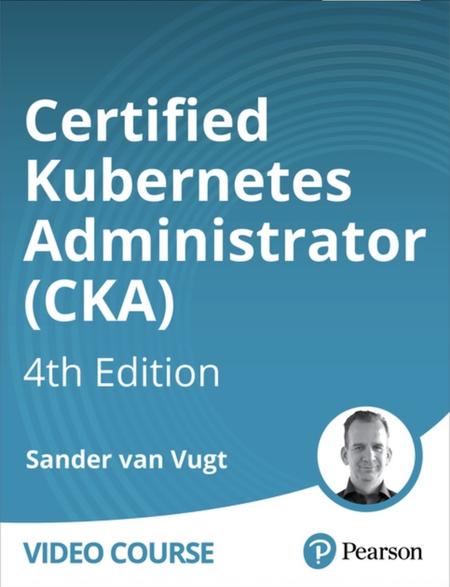English | MP4 | AVC 1280×720 | AAC 44KHz 2ch | 4h 47m | 1.23 GB
Get the edge you need to ace the Certified Kubernetes Administrator (CKA) exam!
- Explore each exam objective on the CKA exam and learn how to build, run, and manage Kubernetes clusters
- Get hands-on labs to work with Kubernetes and get the opportunity to test your skills
- Get sample exam to practice preparing for the exam day
Certified Kubernetes Administrator (CKA), 4th Edition is your ultimate resource for acing the CKA exam. This comprehensive guide equips you with the knowledge and skills to run containerized applications seamlessly in a Kubernetes cluster and effectively manage Kubernetes clusters. It is designed to simulate the real exam experience by including a sample exam that encompasses all the necessary skills required for success. Additionally, it offers an exam-grade script, allowing you to evaluate your performance on the sample exam and receive a PASS/FAIL score.
It begins with an introduction to containers and Kubernetes, gradually progressing to guide you through the creation, management, and storage of applications. Furthermore, hands-on labs provide practical experience in setting up and managing clusters, as well as troubleshooting Kubernetes applications and cluster nodes. In this course, you will master the art of managing deployments, services, ingress, and storage setup. The course also delves into key troubleshooting scenarios, equipping you with the skills to resolve any challenges that might arise.
Table of Contents
Introduction
Certified Kubernetes Administrator (CKA): Introduction
Module 1: Cluster Architecture, Installation, and Configuration
Module Introduction
Lesson 1: Understanding Kubernetes Architecture
Learning objectives
1.1 Vanilla Kubernetes and the Ecosystem
1.2 Running Kubernetes in Cloud or on Premises
1.3 Kubernetes Distributions
1.4 Kubernetes Node Roles
Lesson 2: Creating a Kubernetes Cluster with kubeadm
Learning objectives
2.1 Understanding Cluster Node Requirements
2.2 Provisioning an Infrastructure for Hosting Kubernetes
2.3 Installation Procedure Overview
2.5 Installing CRI and Tools
2.6 Using kubeadm init
2.7 Configuring the Kubernetes Client
2.8 Setting up Node Networking
2.9 Adding Nodes to the Cluster
Lesson 2 Lab: Building a Kubernetes Cluster
Lesson 2 Lab Solution: Building a Kubernetes Cluster
Lesson 3: Managing Kubernetes Clusters
Learning objectives
3.1 Analyzing Cluster Nodes
3.2 Using crictl to Manage Node Containers
3.3 Running Static Pods
3.4 Managing Node State
3.5 Managing Node Services
Lesson 3 Lab: Running Static Pods
Lesson 3 Lab Solution: Running Static Pods
Lesson 4: Performing Node Maintenance Tasks
Learning objectives
4.1 Using Metrics Server to Monitor Node and Pod Performance
4.2 Backing up the Etcd
4.3 Restoring the Etcd
4.4 Performing Cluster Node Upgrades
4.5 Performing Cluster Worker Upgrades
4.6 Understanding Cluster High Availability Options
4.7 Setting up a Highly Available Kubernetes Cluster
Lesson 4 Lab: Etcd Backup and Restore
Lesson 4 Lab Solution: Etcd Backup and Restore
Lesson 5: Managing Security Settings
Learning objectives
5.1 Understanding API Access
5.2 Managing Security Context
5.3 Users, ServiceAccounts, and API Access
5.4 Understanding Role Based Access Control (RBAC)
5.5 Setting up RBAC for ServiceAccounts
5.6 ClusterRoles and ClusterRoleBindings
5.7 Setting up RBAC for Users
Lesson 5 Lab: Managing Security
Lesson 5 Lab Solution: Managing Security
Module 2: Workloads and Scheduling
Module Introduction
Lesson 6: Deploying Kubernetes Applications
Learning objectives
6.1 Using Deployments
6.2 Running Agents with DaemonSets
6.4 The Case for Running Individual Pods
6.5 Managing Pod Initialization
6.6 Scaling Applications
6.8 Using Sidecar Containers for Application Logging
Lesson 6 Lab: Running a DaemonSet
Lesson 6 Lab Solution: Running a DaemonSet
Lesson 7: Using Templating Tools
Learning objectives
7.1 Running Applications from YAML Files
7.2 The Helm Package Manager
7.4 Managing Applications with Helm
7.5 Using Kustomize
Lesson 7 Lab: Managing Applications with Helm
Lesson 7 Lab Solution: Managing Applications with Helm
Lesson 8: Managing Scheduling
Learning objectives
8.1 Exploring the Scheduling Process
8.2 Setting Node Preferences
8.3 Managing Affinity and anti-Affinity Rules
8.4 Managing Taints and Tolerations
8.5 Configuring Resource Limits and Requests
8.6 Setting Namespace Quota
8.7 Configuring LimitRange
8.8 Configuring Pod Priorities
Lesson 8 Lab: Configuring Taints
Lesson 8 Lab Solution: Configuring Taints
Resolve the captcha to access the links!
